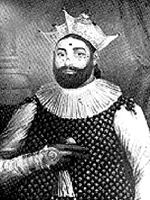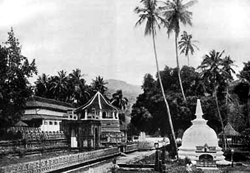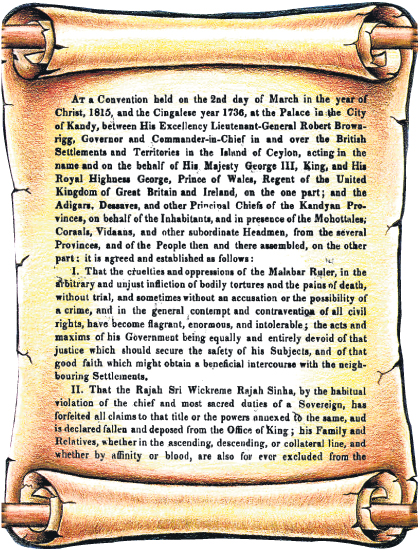
A kingdom is born, a kingdom is lostAs the country remembers the Kandyan Convention of March 2, 1815, Ananda Pilimatalavuva traces the rise and fall of the Kandyan kingdom The story of the emergence of Senkadagala Mahanuvara or Kandy and the chief institutions therein are wrapped in legend and history. Its beginnings, according to ancient tradition recorded in the 'Asgiri Upatha' and ancient lore are, that, during the reign of King Gajabahu of Anuradhapura, a Brahmin ascetic named Senkhanda (Senkada) was practising asceticism in a cave in Mayarata, which in fact lies in Ruhunu Rata in the central region of the island. One day, a man who had lost his way in the jungle had come across this ascetic. The ascetic having hosted the man in the traditional manner, had related some strange occurrences he had witnessed on this land. Firstly, he had said, that one day he had seen a jackal chasing a hare, when suddenly it turned around and started chasing the bewildered jackal! This was not all. On another day he had seen a rat snake chasing a frog and lo and behold, suddenly the frog turned around and chased the rat snake.
These were unusual occurrences which he had witnessed, and hence he concluded that this could happen only on a jaya bhoomi - an auspicious land. In addition he also observed that cattle frequently used this ground to rest after feeding, which according to his interpretation, was indicative of a lucky site. When this man finally found his way back to his village in Rajarata, he related his experiences and thereafter, on the instructions of King Gajabahu who was reigning at that time, men cleared the land, planted a bodhi tree and established a village which, thereafter, came to be known as Senkadagala after the Brahmin Senkhanda (Senkada) who lived there in the rock cave, which is extant even to this day. According to another legend, the Brahmin had witnessed a fight between a mongoose and a cobra. After a few vicious snaps at the raised hood of the cobra, the mongoose is reported to have turned tail and scurried off to burrow a little distance away never to return. Again, as superstition was the main arbiter of human decisions, destiny and undertakings during that era, the Brahmin concluded that this was a propitious sign. The author of these stories does not clearly state which Gajabahu was ruling at Anuradhapura when these incidents were recorded. As King Gajabahu I's reign appears to be too far in the distant past if there is any truth it is likely the reference is to King Gajabahu II who ruled from Circa 1132-1153 AC. Senkhanda and the Jaya bhoomi There is another charming story about the origin of this Kingdom according to which the King of the Gampola Kingdom, who was looking for a safer capital city than Gampola, was once out hunting and strayed away from his usual path to the vicinity of the Brahmin Senkhanda's (Senkada's) rock cave. There, he was introduced to, and received by the old Brahmin. The King acknowledging him for his wisdom and sanctity told him the purpose of his mission. The old Brahmin went into his cave and came out with a leather pouch containing some pebbles and along with the King and party proceeded to the area which was then in thick jungle and threw a pebble towards it. From the thick shrub, a hare sprang up and started running. Then Senkhanda threw another pebble at which, a jackal sprang up and gave chase to the hare. After a little distance, the jackal gave up the chase and turned around at which point, the hare began to give chase to the jackal and both vanished from sight. The King and his party were curious and invited the sage to give an explanation for this strange happening. The sage replied, “O King, this is the jaya bhoomi or auspicious land the devas have ordained for the establishment of your kingdom where you will be protected by the mountains and forests and face and fight your enemies and put them to flight.” The King was very impressed by what old Senkhanda said. The King of this story is believed to have been Vikramabahu who reigned sometime between circa 1473-1511 AC. The King brought to an end the power of the great Bandaras who ruled the present area of the Kandy District, and thereafter, established himself at Peradenip-ura, where he is even reported to have had a royal palace at the present Royal Botanic Gardens, finally settling down at the site of the jaya bhoomi or the territory of the Brahmin Senkhanda. Vickramabahu built himself a palace which came to be known as the Sirivardhana Palace and ordered a city to be built there. He named it Senkadagalapura after the Brahmin Senkada who lived in the rock cave as stated earlier. He bequeathed this city to his son Jayaveera I, the heir to the throne. History therefore records this Senasammata Vickramabahu as the founder of the Senkadagala Kingdom. This occurred during the last phase of the 15th Century or, the early part of the 16th Century when the Kingdoms of Kotte and Sitavaka were being absorbed by the Portuguese who had arrived in Sri Lanka. The legend regarding the construction of the Dalada Maligava is another interesting story. The King had come personally with his astrologer Hulangamuve Mulachariya to view the jaya bhoomi. Viewing the marshes and hills around, the King was reluctant to settle there and had instructed the astrologer to consult the oracle for 48 hours. After further consulting the oracle, the astrologer had predicted what would be found on digging the jaya bhoomi. First he said white clay would be found: it was found. Next he said, would come sand, and next he said, there would be water. The astrologer then asked for a white cloth, and the king got excited and asked anxiously whether he expected to find gem stones, but the astrologer said, a white tortoise would be found and it was found.
The King was delighted with the accuracy of the predictions and decided to build the city at the site with his palace there. But, to his disappointment, the astrologer said it was too good a site for his palace and should be the site of a temple. Hence, the King decided to make it a place of Buddhist worship and erected the Dalada Maligava there, later enshrining the Tooth Relic as well. A small pool near the east end of what is now the lake was made for the Kiri ibba (small white tortoise) and it was called the Kiri Muhuda. Later this land was asweddumised as paddy land for the King, and finally the last King converted it into the present lake which also came to be known as the Kiri Muhuda. Founder Senasammata Vikrambahu In later history, we have two Kings bearing the name Vikramabahu. One had his seat at Gampola. The Ampitiya Rock inscription speaks of him as Siri Sangabo Sri Vikramabahu, who had reigned between circa 1357-1374 AC. The other is, Senasammata Vikramabahu, who is popularly identified in tradition as the founder of the Kandyan Dynasty, and Senkadagalapura (Kandy) the capital of the kingdom. He reigned between circa 1473-1511 AC, that is nearly a century later than the Gampola King. Therefore, although some historians concede that Gampola Vikramabahu is the same as the other, this is untenable: they are two different kings. This error had been detected and corrected by both Codrington and Hettiarachchi. Also in the last part of Mahavamsa, which was appended much later, the King who is mistakenly referred to as Viravikrama, is also in fact, Senasammata Vikramabahu.
As far as evidence is traceable, for all scientific purposes, leaving apart legendary material and other conflicting claims, it is Senasammata Vikramabahu who appears to be the founder of the Kandyan Kingdom, and has been accepted as such by serious historians. This city of Senkadagalapura established sometime between circa 1473-1511, was a very beautiful city in fairly close proximity to the Mahaveli ganga which encircles it and in fact, could be described as having been a typical feudal township. The population of the city comprised mainly of the chieftains, mudliyars, arachchis and other courtiers and their families along with the traders and merchants. There were also many places of Buddhist worship with the Sangha playing a prominent role. The King built a cetiya for the relics of Lord Buddha at a site close to the palace and also erected a two storied building for the meetings of the Sangha. The Upasampada ceremony was held on the banks of the river where the Grand Thero Dhammakitti conducted the ceremonies and inducted 350 males of good family chosen personally by the King for the priesthood. Kandyan dynasty and Vimaladharmasuriya I King Parakramabahu VI of Kotte, circa 1411-1467 AC, staked the first claims on this mountain nucleus of Kande by appointing a prince of the royal house as administrator of the Kande Uda territories. His successors had nominal control. This central mountain kingdom at the beginning of the 16th Century or last decade of the 15th Century, was a semi-independent kingdom owning tribute to the Kings of Kotte. Thereafter the continuance of Senkadagala as the seat of the Kandyan kingdom, according to latest research can be traced through Kings Senasammata Vikramabahu, circa 1473-1511 its founder, the grandson of Parakramabahu VI; Jayaveera I, circa 1511-1521 AC; Jayaveera II (Vikramabahu) circa 1521 to 1551 AC; Karalliadde Kumara Bandara, circa 1551 to 1582 AC; (Rajasinha I, of Sitavaka circa 1582 to 1592 AC to Konnappu Bandara, baptized under the name of Don Joan (Juan) of Austria who captured the throne, married Princess Kusmasana Devi (Dona Catharina) in 1594, the rightful heir to the throne, embraced the Buddhist faith and established himself on the throne as Vimaladharmasuriya I (circa 1592-1604 AC). He is regarded by some historians as the second founder, or more correctly the reviver of the Kandyan Kingdom. After renouncing the Catholic religion and embracing Buddhism, King Wimaladharmasuriya I constructed a magnificent two-tiered shrine close to his palace to sanctify his capital by honouring and accommodating the Sacred Tooth Relic, the palladium of the Sinhala Royalty. During this early period when the Portuguese were attempting to gain a foot hold on the island, they called the central highlands Cande, Candihure, Quande, Camdia and Candea. The four main provinces or Disavanies of Kande Uda, at that time were Harasiya-Pattuva, Pansiya-Pattuva, Udunuvara and Yatinuvara. Its ruler also exercised suzerainty over Uva and the chieftaincies of Batticalo, Trincomalee, Panama, Kotiar, and Yala and the Vidanas of Bintenna, Vellassa and Maturata as well. This city in the central highlands was hemmed in by mountains and forests which made it inaccessible even to the rulers of Kotte and Sitavaka, and the foreigners who tried to occupy it. The approaches were from Jaffna, Yala, Negombo, Kotte and Colombo, the most popular routes being the last two via Sitavaka. The route through Sitavaka was similar to the Great Road used from the late 16th Century up to the early 19th Century. The Tooth Relic which was kept in hiding at Delgamuva Vihare in Sabaragamuva was finally brought in procession and deposited in the newly constructed shrine in Kandy the Dalada Maligava by Vimaladharmasuriya I. The golden age of the Kandyan Kingdom now began under this monarch, and lasted through the reign of Senarat, 1604-1635 AC; Rajasimha II, 1635-1687 AC; Vimaladharmasuriya II, 1687-1707 AC; and Sri Veera Parakrama Narendrasimha 1707-1739 AC, the last Sinhala King. Vaduga Nayakkar dynasty and the end of the Kingdom As King Sri Veera Parakrama Narendra Simha who succeeded Vimaradharmasuriya II married Nayakkar princesses from South India and was childless by them, on his death bed he nominated his Vaduga Nayakkar brother-in-laws of South Indian origin to succeed him, even rashly overlooking the right of Unambuwe Bandara, his own son by a Sinhalese concubine. This led to the first South Indian Vaduga Nayakkar to ascend the Throne of Kandy under the Sinhalese name Sri Vijaya Rajasimha in 1739 AC, violating all ancient traditions of kingship. After him two of his brothers-in-laws at on the throne as Kirti Sri Rajasimha (1747-1781 AC) and Rajadhi Rajasimha (1781-1798 AC). The latter Rajadhi Rajasimha being enthroned at the insistance of Pilmatalavuva Maha Adikaram II in 1781 AC. They too died without issues, and finally were succeeded by Sri Wickrama Rajasimha (1798-1815 AC), the son of the dowager queen's sister enthroned at the instance of Pilimatalavuva III, the Maha Adikaram at the time. The Vaduga Nayakkars embraced Buddhism, learnt the Sinhalese language and made every effort to naturalise themselves, but cunningly avoided marrying into the local Radala families, the aristocracy. They went on to rule the Kandyan Kingdom for another seventy six years until the last of them, Sri Wickrama Rajasimha was dethroned in 1815 AC with the assistance of the British. It was Sri Wickrama Rajasimha though notorious for his alcoholism and cruelty, who completed the Dalada Maligava complex by constructing the beautiful octagonal Pattirippuva, and thereafter the picturesque lake. During his reign two of his Maha Adikarams, Pilimatalavuva III and Ehelapola III in turn planned to re-establish a Sinhala dynasty to rule Sinhale (Sri Lanka). Sensing the situation, it led to constant friction between the King and his Maha Adikarams and finally resulted in the beheading in 1811 of Pilimatalavuva Maha Adikaram, his greatest benefactor who elevated him to the throne, and the severe punishment meted out to the innocent family of Ehelepola Maha Adikaram involving the beheading of his three children and the drowning of the ladies of the family in the Bogambara lake, to avenge Ehelepola Nilame's escape to Colombo and joining the British. In retaliation to this crime, Ehelepola helped the British to enter Sinhale (Kandyan Kingdom) and capture the King. After the capture of the King by the joint operations of the oppressed Kandyans and the British forces on February 18, 1815 at Gallehevatte near Bomure in Medamahanuvara, the King was taken prisoner and sent to Colombo under escort on March 6, 1815 and from thence to Madras on January 24, 1816 by the ship Cornwallis. He died an open prisoner in Vellore on January 30, 1832, aged 52 years. After his capture, a Convention was proclaimed on March 2, 1815 between the British King's representatives and the Kandyan Chieftains acting on behalf of the people, and the Kingdom was ceded to King George III of England. Thus ended one of the oldest indigenous monarchies of the world after 2358 years of continuous existence! The last phase The Kandyan chieftains really exchanged the Nayakkar dynasty with the Windsor dynasty of England who were of Aryan stock replacing the wholly alien Dravidian power. The country now began to be ruled by a government representing the King of England who was never physically present in the kingdom. The convention of 1815 soon became restricted to a piece of paper and the chieftains found their powers, ancient customs and above all Buddhism gradually restricted unlike under the native Kings. This disillusionment had to burst at some point and finally manifested itself in what came to be known as the Great Uva Rebellion of Freedom 1817-1818 where nearly every section of the common peasantry along with the bhikkhus and the dissatisfied nobility made one last glorious attempt to rid the country of its foreign rulers. Alas, this last attempt in spite of all the valiant fighting by the peasantry under their chieftains, finally succumbed to the might of superior British fire power as they were able to bring in reinforcements from India who annihilated several thousands of Kandyan Sinhalese people, including children, the sick and the old. The struggle therefore was bound to fail, and fail it did, due to the military might of the English and in some measure due to the bickering and failure of the Sinhalese to decide on a single strong leader. Invariably the family jealousies surfaced breeding traitors who were prepared to carry tales and curry favour with the British for office and position. |
| || Front
Page | News
| Editorial
| Columns
| Sports
| Plus
| Financial
Times | International | Mirror
| TV
Times | Funday
Times | Kandy
Times || |
| |
Copyright
2007 Wijeya
Newspapers Ltd.Colombo. Sri Lanka. |


